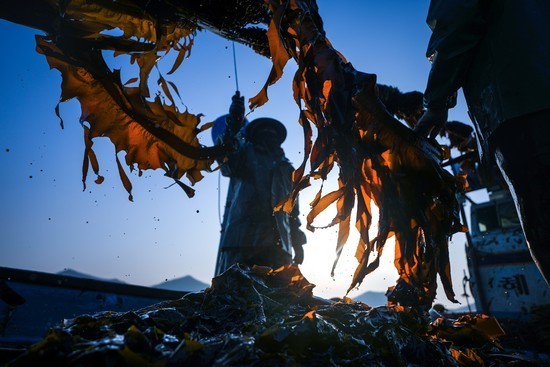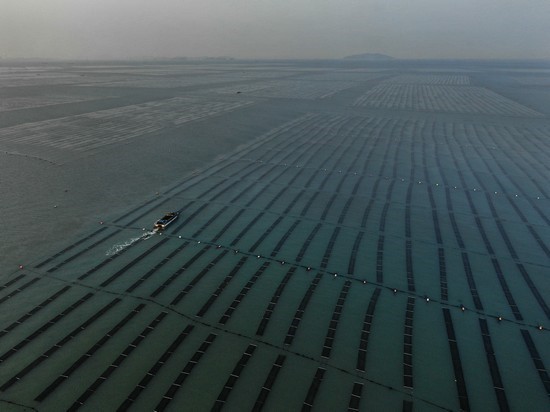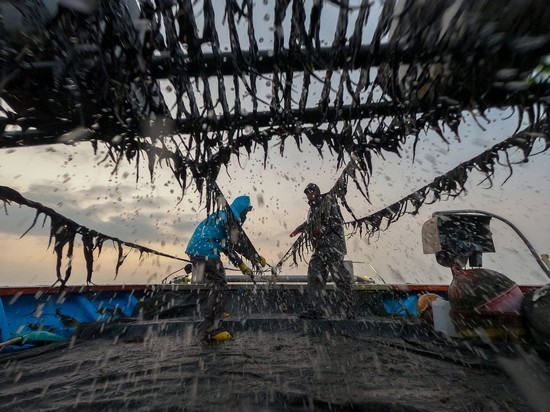For centuries, it has been
treasured in kitchens in Asia and neglected almost everywhere else: those
glistening ribbons of seaweed that bend and bloom in cold ocean waves.
اضافة اعلان
Today, seaweed is suddenly a hot global
commodity. It is attracting new money and new purpose in all kinds of new
places because of its potential to help tame some of the hazards of the modern
age, not least climate change.
“Seaweed is not going to replace all plastic, but seaweed combined with other things can tackle single-use plastic,” he said. “We are barely scratching the surface.”
In London, a startup is making a plastic
substitute out of seaweed. In Australia and Hawaii, others are racing to grow
seaweed that, when fed to livestock, can cut methane from cow burps.
Researchers are studying just how much carbon dioxide can be sequestered by
seaweed farms as investors eye them as a new source of carbon credits for
polluters to offset their greenhouse gas emissions.
And in South Korea, one of the most
established seaweed-growing countries in the world, farmers are struggling to
keep up with growing export demand.
What was mainly a relatively small Asian
industry is now coveted by the West. Far beyond South Korea, new farms have
cropped up in Maine, the Faeroe Islands, Australia, even the North Sea.
Globally, seaweed production has grown by nearly 75 percent in the past decade.
The focus is moving far beyond its traditional use in cuisine.
 A crew of seaweed farmers, harvest seaweed near
Geumdang Island in Wando-Gun, South Korea, on March 24, 2022.
A crew of seaweed farmers, harvest seaweed near
Geumdang Island in Wando-Gun, South Korea, on March 24, 2022.
But even as its champions see it as a
miracle crop for a hotter planet, others worry that the zeal to farm the ocean
could replicate some of the same damages of farming on land. Much is unknown
about how seaweed farms, particularly those far offshore, can affect marine
ecosystems.
“Seaweed protagonists believe seaweed is a
cure to everything, that seaweed is a magical panacea for climate problems,”
said David Koweek, chief scientist for Ocean Visions, a consortium of research
organizations studying ocean-based interventions for the climate crisis.
“Seaweed antagonists think seaweed is completely overhyped.”
There is another problem. Seaweed is itself
feeling the impact of climate change, particularly in Asia.
“The water is way too hot,” said Sung-Kil
Shin, a third-generation seaweed farmer, as he pulled his boat into harbor one
morning on Soando Island, just south of the South Korean mainland, where
seaweed has long been foraged and farmed.
‘Plastic’ from seaweedPierre Paslier once made a living by
designing plastic packages for cosmetics. It felt to him like “leasing out my
brain to a big plastic polluter”.
He wanted out. He wanted to create
packaging that would come from nature and disappear into nature, quickly. With
a friend from graduate school, Rodrigo García González, he created a company
called NotPla, short for “not plastic”.
From an East London warehouse, they
designed an edible sachet of water, made of seaweed and other plant extracts:
To drink the water, you simply pop the sachet in your mouth. They designed
another one that can hold ketchup and a third for cosmetics.
 Seaweed farmers harvest seaweed near Seonjaedo island,
South Korea.
Seaweed farmers harvest seaweed near Seonjaedo island,
South Korea.
They also began making a seaweed-based
coating for takeout cardboard boxes. Just Eat, a food delivery app in Britain,
began using it for some of its orders, including at the European women’s soccer
finals in July at Wembley Stadium.
It is still niche. The seaweed coating,
designed for home composting bins, is considerably more expensive than the
plastic coating now used on most takeout boxes made of paper.
But Paslier is looking to the future. The
European Union has a new law restricting single-use plastic. A global plastics
treaty is under negotiation.
“Seaweed is not going to replace all
plastic, but seaweed combined with other things can tackle single-use plastic,”
he said. “We are barely scratching the surface.”
Foragers from the pastIn the gray light of dawn, Soon-Ok Goh, a
slight 71-year-old, swam soundlessly in the shallow waters of Gijang, on the
southern coast of South Korea. Her feet were sheathed in yellow flippers, her
thin, small frame in a wet suit. She surfaced above water for a few seconds, took
a long breath that sounded almost like a whistle in the quiet of the morning,
then dived down again, yellow flippers upturned.
“The race is on, I suppose, to get the world’s first commercial supply,” Meller said. “The demand is off-the-roof scale.”
Goh is among the last practitioners of a
vanishing trade. Since the end of the seventh century, women like her have
foraged for wild seaweed, along with other seafood, in the chilly waters around
the Korean Peninsula.
This morning, a tiny pink-handled knife in
hand, she snipped shiny green-brown ribbons of kelp called miyeok. She plucked
sea snails clinging to rocks, two kinds of sea cucumbers, a handful of
kelp-devouring sea urchins.
All went into her sack.
In decades past, when there was no money to
buy rice, you could go to the sea and find seaweed, said Hye Kyung Jeong, a
food historian at Hoseo University in Seoul, South Korea. “Seaweed helped
people survive during famines,” she said.
 Seaweed farmers harvest seaweed near Soando Island,
South Korea.
Seaweed farmers harvest seaweed near Soando Island,
South Korea.
This is not the first time seaweed has
helped avert a crisis.
Slimy arms raceThe new frontier for seaweed production
lies beyond Asia.
Steve Meller, an American businessperson in
Australia, grows seaweed in giant glass tanks on land — specifically, a red
seaweed native to the waters around Australia called asparagopsis, which beef
and dairy companies are eyeing as a way to meet their climate goals.
A sprinkle of asparagopsis in cattle feed
can cut methane from their burps by between 82 percent and 98 percent,
according to several independent studies. Cattle burps are a major source of
methane, a potent greenhouse gas.
“The race is on, I suppose, to get the
world’s first commercial supply,” Meller said. “The demand is off-the-roof
scale.”
His company, named CH4, after methane’s
chemical formula, is competing to bring asparagopsis to the mouths of cows. At
least two other Australian startups, Sea Forest and Rumin8, are in the
seaweed-for-cattle race. So are Symbrosia and Blue Ocean Barns, both in Hawaii.
Fonterra, a New Zealand dairy producer, has
begun commercial trials of the seaweed supplement, and Ben & Jerry’s is planning
its own trials soon. The global dairy giant Danone has invested in an
asparagopsis startup.
Whether seaweed can make a dent in cattle
methane remains unclear. In the US, there is another hurdle to overcome:
regulatory approval.
Nevertheless, it could be key to the beef
and dairy industry’s ability to meet climate goals. Emissions from food systems
alone, mainly meat and dairy, could raise the global average temperature by 1
degree Celsius by the end of the century, blowing past the threshold of relatively
safe global warming, researchers have said.
Climate pressuresSeabirds dive and squawk around the fishing
port in Soando, an island off the southern tip of South Korea, as Shin’s boat
pulls in with the morning’s harvest.
“People want more seaweed these days,” he said. “But there’s no more seaweed.”
Shin, 44, has plied these waters for 20
years and has seen climate change upend his trade. He grows a red kelp species
called pyropia, which favors cold water during its growing season. So he has
been going further and further from shore in search of chilly waves.
By mid-April, Shin said, the water is not
as cold as pyropia likes. His yield has suffered. “People want more seaweed
these days,” he said. “But there’s no more seaweed.”
Since 1968, the waters where Shin farms
have warmed by 1.4 degrees Celsius, slightly higher than the global average.
That is why South Korean scientists are racing to breed strains that can thrive
in warmer waters.
Seaweed farms are a far cry from the rows
of corn and wheat that make up monoculture farming on land. But even as they
signify new opportunities, they present ecological risks, many of them unknown.
They could block sunlight to creatures who
need it below. They could scatter plastic buoys in the sea, which already
suffers from too much plastic. They could leave their plant detritus on the seafloor,
altering the marine ecosystem.
“It needs to be carried out with a great
deal of care,” said Scott Pillias, a doctoral student in economics who studies
marine systems at the University of Queensland. “We shouldn’t expect seaweed to
save us.”
Read more Odd and Bizarre
Jordan News








